Слайд 2Heart
Hollow, muscular organ
Mediastinum between the lungs resting on the diaphragm, tilting

forward and to the left
Pumps 60mL of blood (5 L/min)
Encapsulated by pericardium
Слайд 3Heart
Muscle tissue layers
- epicardium (visceral pericardium)
> thin & transparent
- myocardium (cardiac muscle

tissue)
> striated muscle fibers
- endocardium (smooth endothelial tissue)
Слайд 4Chambers of the Heart
Right atrium
- receives unoxygenated blood from peripheral tissues through

SVC and IVC
Right ventricle
- propels blood into the pulmonary artery & lungs
- low-pressure system
Слайд 5Chambers of the Heart
Left atrium
- receives oxygenated blood from the 4 pulmonary

veins
Left ventricle
- largest & most muscular chamber
- high pressure system
- propels blood through the aorta to the periphery
Слайд 6Heart Valves
Atrioventricular valves
- Tricuspid valve (3 leaflets)
> separates RA from RV
- Bicuspid

valve (mitral valve)
> separates LA from LV
Semilunar valves
- Pulmonic valve
> separates RV from the pulmonary artery
- Aortic valve
> separates LV from the aorta
Слайд 7Coronary Arteries
Originates from the aorta just beyond the aortic valve
Coronary blood flow

to the myocardium occurs primarily during diastole
* To maintain adequate blood flow through the coronaries, mean arterial pressure (MAP) must be at least 60 mmHg
Слайд 8Coronary Arteries
Left main coronary artery (LCA)
- Left anterior descending artery (LAD)
>descends toward

the anterior wall & apex of LV
> supplies LV, ventricular septum, chordae, papillary muscle & RV
- Left circumflex artery (LXA)
> descends toward the lateral wall of LV & apex
> supplies LA, lateral & posterior LV surfaces
*45% supplies SA node
Слайд 9Coronary Arteries
Right main coronary artery (RCA)
- descends toward the apex of RV
-

supplies the RA, RV, & inferior portions of LV
Слайд 11Physiology of the Heart
Electrophysiologic properties (regulates heart rate & rhythm)
- Automaticity –

ability of all cardiac cells to initiate an impulse spontaneously & repetitively
- Excitability – ability of cardiac cells to respond to stimulus by initiating an impulse (depolarization)
- Conductivity – cardiac cells transmit the electrical impulses they receive
- Contractility – cardiac cells contract in response to an impulse
- Refractoriness – cardiac cells are unable to respond to a stimulus until they’ve recovered (repolarized)
Слайд 12Conduction System of the Heart
Sinoatrial node (SA node)
- pacemaker cells initiate impulses

at 60 – 100 beats/min
Atrioventricular node (AV node)
- located in the junctional area
- normal delay (allows the atria to contract completely before the ventricles are stimulated to contract)
- 40 – 60 beats/min
Bundle of His
- located in the interventricular septum
- Left and Right bundle branches
Purkinje fibers
- terminal branches that carry the impulse to RV & LV
- 20 – 40 beats/min
Слайд 13Cardiac Cycle
Diastole
- relaxation and filling of the atria and ventricles
- “dub”
Systole
-

contraction and emptying of the atria & ventricles
- “lubb”
Слайд 15Cardiac Muscle Contraction
Release of large amounts of Calcium ions from the sarcoplasmic

reticulum of myocardial cells
Ca ions diffuse into the myofibril sarcomere (basic contractile unit of the myocardial cell)
Ca ions promote interaction of actin & myosin protein filaments causing the filaments to link & overlap (cross-bridges or linkages)
Sliding of protein filaments shortens sarcomere producing contraction
Слайд 16Mechanical Properties of the Heart
Cardiac output
- volume of blood (liters) ejected by

the heart each minute
- 4 – 7 L/min
- heart rate x stroke volume
Heart rate
- number of times the ventricles contract each minute
- 60 – 100 beats/min
- controlled by the ANS via the vagus nerve
Stroke volume
- amount of blood ejected by the LV during each systole
Слайд 17Mechanical Properties of the Heart
Preload
- degree of myocardial stretch at the end

of diastole & just before contraction
- determined by the amount of blood returning to the heart from the venous ® & pulmonary system (L) – LVED
*Starling’s law – the more the heart is filled during diastole, the more forcefully it contracts
Слайд 18Mechanical Properties of the Heart
Afterload
- pressure or resistance that the ventricles must

overcome to eject blood through the semilunar valves & into the peripheral blood vessels
- directly proportional to the BP & diameter of blood vessels
Impedance (peripheral component of afterload)
- pressure that the heart must overcome to open the aortic valve
- depends on aortic compliance, blood viscosity & arteriolar constriction
Слайд 19Mechanical Properties of the Heart
Myocardial contractility
- force of cardiac contraction independent of
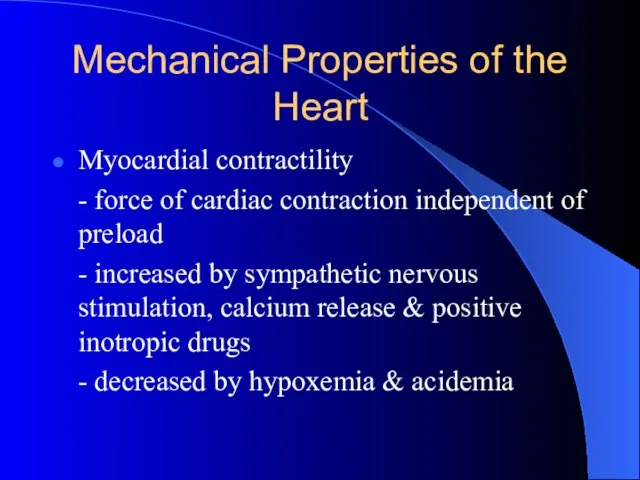
preload
- increased by sympathetic nervous stimulation, calcium release & positive inotropic drugs
- decreased by hypoxemia & acidemia
Слайд 20Vascular System
Provide conduits for blood to travel from the heart to nourish

the body
Carry cellular wastes to the excretory organs
Allow lymphatic flow to drain tissue fluid back to the circulation
Return blood to the heart for recirculation
Слайд 21Arterial System
Delivers blood to various tissues for nourishment
Transport of cellular wastes
Contribute to
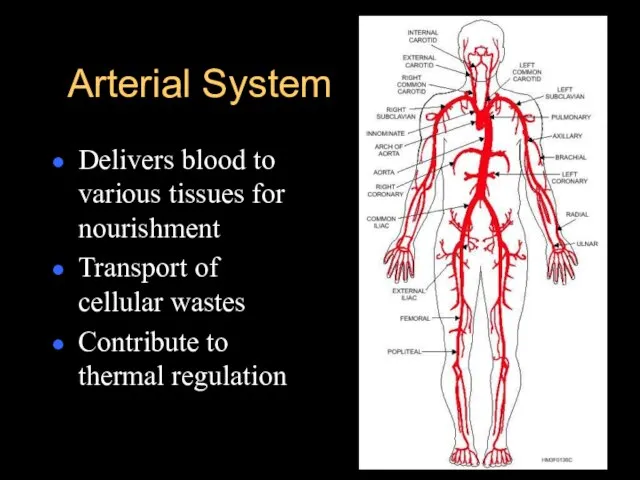
thermal regulation
Слайд 22Arterial System
Blood pressure
- force of blood exerted against the vessel walls
= CO
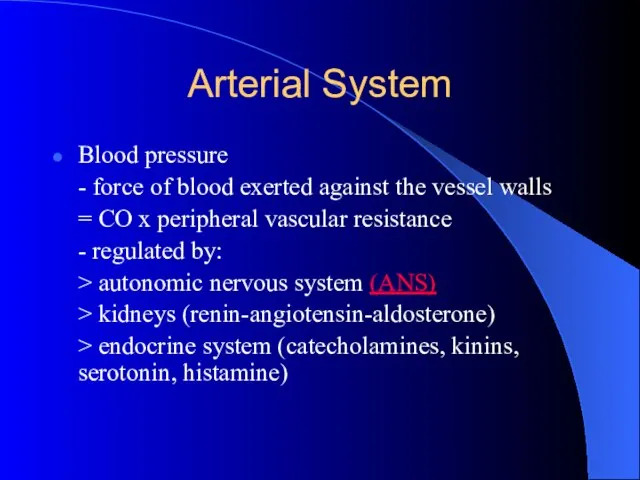
x peripheral vascular resistance
- regulated by:
> autonomic nervous system (ANS)
> kidneys (renin-angiotensin-aldosterone)
> endocrine system (catecholamines, kinins, serotonin, histamine)
Слайд 23Blood Pressure
Systolic:
- amount of pressure/force generated by LV to distribute blood

into the aorta w/ each contraction of the heart
- 90 – 135 mmHg (120)
- affected by CO and arterial distention
Diastolic:
- amount of pressure/force sustained by the arteries during the relaxation phase of the heart
- ability of the heart to rest while filling with blood
- affected by peripheral vascular resistance
- 60 – 85 mmHg (80)
Слайд 24Regulation of BP
Autonomic Nervous System
- Baroreceptors (arch of aorta & origin of
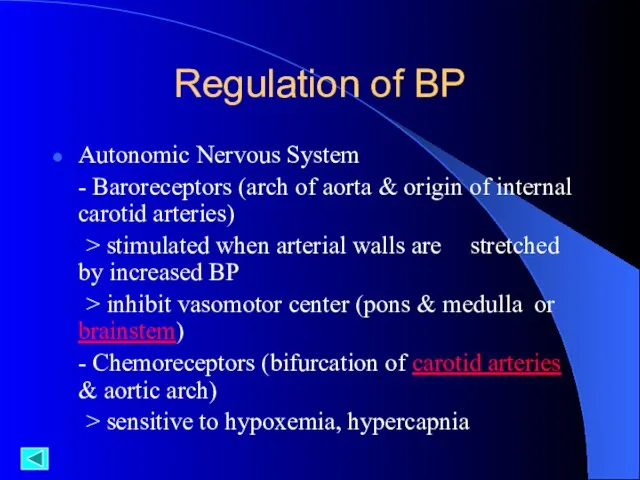
internal carotid arteries)
> stimulated when arterial walls are stretched by increased BP
> inhibit vasomotor center (pons & medulla or brainstem)
- Chemoreceptors (bifurcation of carotid arteries & aortic arch)
> sensitive to hypoxemia, hypercapnia
Слайд 25Venous System
Series of veins located adjacent to arterial system
Veins collect blood from
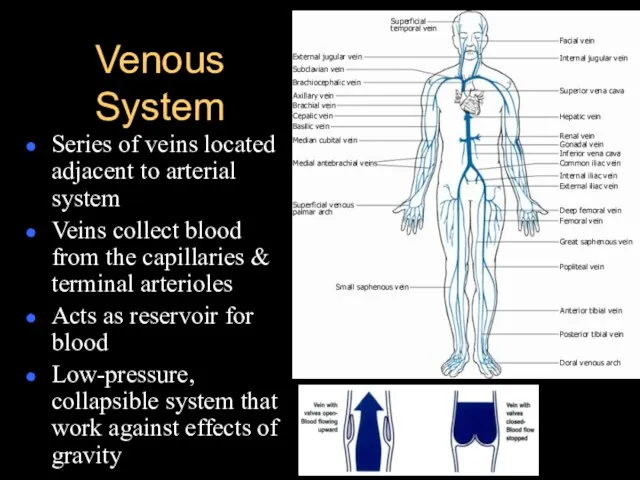
the capillaries & terminal arterioles
Acts as reservoir for blood
Low-pressure, collapsible system that work against effects of gravity
























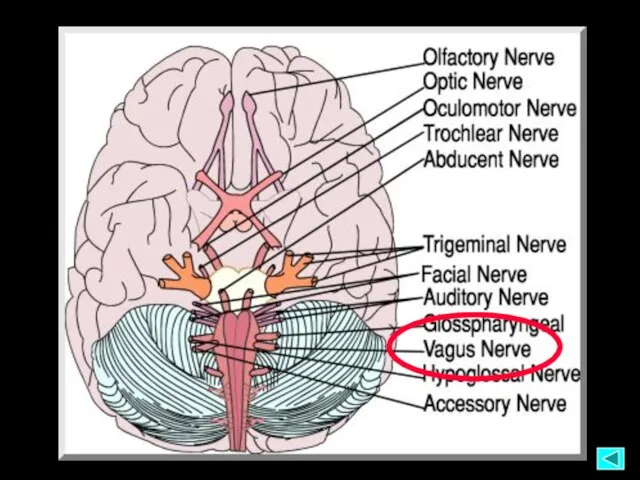
 Московский лабиринт
Московский лабиринт Теория вероятностей и статистика
Теория вероятностей и статистика Presentation Title
Presentation Title  Тест на творческое мышление
Тест на творческое мышление Обособленные определения
Обособленные определения Термопанели из натурального мрамора с высокой износостойкостью
Термопанели из натурального мрамора с высокой износостойкостью Как изменялись способы движения в ходе эволюции животного мира
Как изменялись способы движения в ходе эволюции животного мира Электронные деньги и их свойства
Электронные деньги и их свойства Обожаемому Шамсиэлю. Анафиэль. Нургисаева Айжана
Обожаемому Шамсиэлю. Анафиэль. Нургисаева Айжана Презентация на тему Социально-психологические аспекты адаптации первоклассников
Презентация на тему Социально-психологические аспекты адаптации первоклассников Иммунологическая несовместимость между матерью и плодом
Иммунологическая несовместимость между матерью и плодом  Су құбырлы электржетегтерді ауылшаруашылығында пайдыланылуы (водопровод с элетроприводом)
Су құбырлы электржетегтерді ауылшаруашылығында пайдыланылуы (водопровод с элетроприводом) Основы трудового права России
Основы трудового права России Губернаторский проект Наши дворы
Губернаторский проект Наши дворы Сравнение принципов образования количественных числительных в русском и английском языках
Сравнение принципов образования количественных числительных в русском и английском языках Духовный мир человека
Духовный мир человека Устройство персонального компьютера
Устройство персонального компьютера Лето
Лето Данная презентация предназначена для обучения общественных контролеров в участковых избирательных комиссиях на выборах депутат
Данная презентация предназначена для обучения общественных контролеров в участковых избирательных комиссиях на выборах депутат Представление о расах
Представление о расах Архитектура ИКТ – организационная, юридическая и технологическая модель взаимодействий
Архитектура ИКТ – организационная, юридическая и технологическая модель взаимодействий Польская литература в рассказах … Болеслав Прус. Шарманка. Bolesław Prus. „Katarynka”
Польская литература в рассказах … Болеслав Прус. Шарманка. Bolesław Prus. „Katarynka” Логика и ее свойства
Логика и ее свойства Дк ақаулығы
Дк ақаулығы Информация и её разновидности
Информация и её разновидности ПСИХИКА ЖИВОТНЫХ И ЧЕЛОВЕКА
ПСИХИКА ЖИВОТНЫХ И ЧЕЛОВЕКА Политические системы. Типология
Политические системы. Типология Презентация на тему Джеймс Кук
Презентация на тему Джеймс Кук